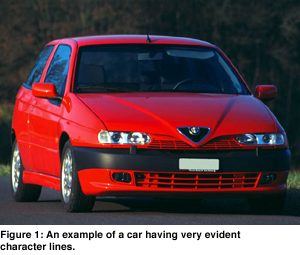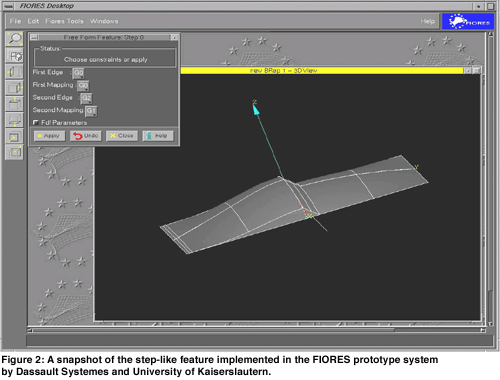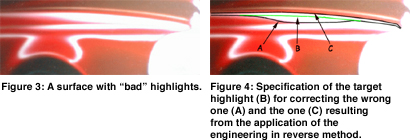
ERCIM News No.44 - January 2001 [contents]

![]()
ERCIM News No.44 - January 2001 [contents]
by Chiara Catalano, Bianca Falcidieno, Franca Giannini, Maria Meirana and Marina Monti
The definition of tools to support design intent representation and management during product development is a key issue for new CAD systems. In the context of product styling development, the design intent is represented by the shape of the resulting product and can be schematized by the defining character curves and by the behavior of the reflection of light over the surface. In order to provide tools for the direct manipulation of the shape through character curves, in the FIORES project the form feature concept has been extended to the aesthetic design domain. Algorithms for surface modification through target shadow line specification have also been implemented.
In a competitive world wide market, where product life time is being reduced, quality and cost are not necessarily the only important key elements for success: the aesthetic aspect is also becoming fundamental in customers’ decisions. Furthermore, the availability of new materials and production tools makes the fabrication of very complex shapes possible, thus permitting a greater freedom in design.
Computer-aided tools have been developed to support styling, providing high quality rendering and animation facilities for the purposes of simulation and evaluation, thus reducing the number of physical prototypes and cutting design costs.
Unfortunately, current CAD/CAS systems do not support the fast generation of alternative shapes starting from existing models. It is sometimes very difficult to change a small detail and can cost more than re-creating the entire model.This is due to the fact that the modelling activity is based on low level geometric elements (eg NURBS/B-Splines control points and nodes) completely unrelated to the design intent of the stylist.
In order to overcome these limitations, new modelling tools are being developed. The Brite-Euram Project FIORES (Formalization and Integration of an Optimized Reverse Engineering Styling Workflow) focused on this problem. The two main aspects regarding styling considered by the project are identification of free form features for shape modification, and engineering in reverse techniques for surface refinement.
Free Form Features
Feature technology is employed to speed up the model creation process and permit the reuse of existing models. Features are well known and common in mechanical design and their application to styling has required an analysis of the various elements characterizing the product shape.
We have identified two relevant categories of form features:
We have mainly focused on detail features and have proposed a formal definition of feature types on the basis of detail features obtained by modifying a given free form surface locally.
This classification is based on the topological and morphological characteristics associated with the deformation functions used to create the features. Two main classes of features have been identified: those corresponding to elastic deformations and those regarding elimination of surface regions. A feature taxonomy has been specified on the basis of these two classes. It is aimed at allowing the identification of a useful set of intuitive parameters (possibly with aesthetic value) and conditions, which can be hard-coded, to define meaningful deformation with predictable behavior. A feature class has been implemented to demonstrate the feasibility of this approach.
Engineering in Reverse
This approach aims at shortening the frustrating loop reiterating surface modification and aesthetic evaluation of the product model. Many industrial products, such as cars, are evaluated in terms of certain evaluation lines that give the expert designer an idea of the aesthetic quality of the object. These lines range from section curves and reflection lines to special curvature lines. The designer then modifies the object surfaces to make the derived evaluation lines look good.



With the engineering in reverse (EiR) approach adopted by FIORES and implemented by Matra Datavision together with UDK Utveckling and Formtech, the modification loop can be avoided: the designer can directly specify a preferable target evaluation line, and insert additional constraints (such as the modifiable area). The system will return a surface with the given evaluation line. An optimization approach is used to compute the best solution, ie the solution that according to a given criterion is as close as possible to the desired target.
Links:
FIORES web page: http://www.fiores.com
Please contact:
Bianca Falcidieno - IMC-CNR
Tel: +39 010 64751
E-mail: bianca@ima.ge.cnr.it